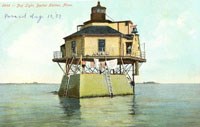|
The oldest lighthouse site in the counrty - the Boston Light - sits here within the Boston Harbor. Given the extensive maritime history of the area, it is not surprising that navigational aids within the harbor date from many different time periods. Of the many major navigational aids built in Boston Harbor, only a few still remain in what is now the Boston Harbor Islands National and State Park:
SEE BOSTON'S LIGHTHOUSESTake a Lighthouse TourAnother major navigational aid, Minot’s Ledge Light, is not actually in Boston Harbor but is part of the historical lore associated with navigational aids in the harbor and therefore merits consideration as part of the historical context of those aids. In addition, there are several non-extant aids that contribute to understanding park resources:

Colonial Period (1607–1789)—During the colonial period in America, aids to navigation were provided by individual colonies. In the 17th century these aids were usually beacons, often lighted. Soon after Newport, Rhode Island, was founded in 1639, for example, fires built on Beavertail Point guided vessels at night. In the 18th century, a chain of beacons was established along Narragansett Bay during the French and Indian and Revolutionary Wars to warn of approaching enemy ships and, not incidentally, to serve as navigational aids (Gleason 1991:4–6). Boston had its share of beacons, too. The famous one on the eponymous Beacon Hill, erected in 1635, was not intended, however, as a navigational aid but rather to warn inland areas of invasion. A similar lighted warning beacon was also constructed on Point Allerton in Hull in 1673, and a daybeacon may have been built on Great Brewster in 1679 or 1681 (Snowman and Thomson 1999:2–4). These warning beacons did not, however, guide ships through the islands and shoals of Boston Harbor. To mark the entrance to the harbor and thereby benefit trade, in 1713 a group of merchants petitioned the legislature for a lighthouse. Little Brewster was chosen as the site, and in 1716 Boston Light was completed—the oldest lighthouse site in North America (Snowman and Thomson 1999:4–6). Other colonies also needed guides to their ports, and 11 additional lighthouses were built before 1789, including Sandy Hook, New Jersey, 1764: still standing and therefore the oldest lighthouse in the United States (Snowman and Thomson 1999:180; Lighthouse Friends 2001b, c; Rudyalicelighthouse.net 2006; D’Entremont 2007a, c, g, k, m, n, o, q). Secretary of the Treasury and Commissioner of Revenue (1789–1820)—When the U.S. government was formed in 1789, one of its first acts was to assume control of all aids to navigation including the 12 existing lighthouses as well as those under construction, placing them under the Treasury Department. During the period from 1789 to 1820 the number of lighthouses increased to 55, though apparently without any system (Noble 1997:6–7). continue reading . . . References |
Last updated: November 5, 2019
